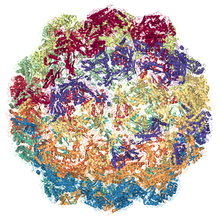
KNOWPIA
WELCOME TO KNOWPIA
Summary
The encapsulins are a family of bacterial proteins that serve as the main structural components of encapsulin nanocompartments.[1] There are several different encapsulin proteins, including EncA, which forms the shell, and EncB, EncC, and EncD, which form the core.[1]
 EM structure of Myxococcus xanthus encpasulin protein (EncA) PDB entry 4pt2 | |||||||||
| Identifiers | |||||||||
|---|---|---|---|---|---|---|---|---|---|
| Symbol | Linocin_M18 | ||||||||
| Pfam | PF04454 | ||||||||
| InterPro | IPR007544 | ||||||||
| |||||||||
Encapsulins are also used in synthetic biology. They are hard to discover due to their similarity to phage proteins.[2]
Function edit
Encapsulins serve many physiological functions, including catalysis, mineral storage, response to oxidative stress and secondary metabolism. There are ferritin-like encapsulins as well.[2]
References edit
- ^ a b McHugh CA, Fontana J, Nemecek D, Cheng N, Aksyuk AA, Heymann JB, Winkler DC, Lam AS, Wall JS, Steven AC, Hoiczyk E (September 2014). "A virus capsid-like nanocompartment that stores iron and protects bacteria from oxidative stress". The EMBO Journal. 33 (17): 1896–911. doi:10.15252/embj.201488566. PMC 4195785. PMID 25024436.
- ^ a b Kashif-Khan N, Savva R, Frank S (7 March 2024). "Mining metagenomics data for novel bacterial nanocompartments". NAR Genomics & Bioinformatics. 6 (1): lqae025. doi:10.1093/nargab/lqae025.


